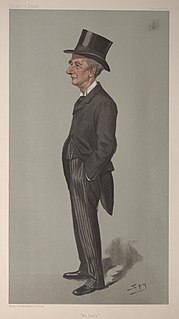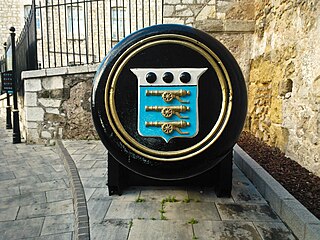See also
| This disambiguation page lists articles about people with the same name. If an internal link led you here, you may wish to change the link to point directly to the intended article. |
John Anson (born 1949) was a wrestler.
John Anson may also refer to:
| This disambiguation page lists articles about people with the same name. If an internal link led you here, you may wish to change the link to point directly to the intended article. |

Earl of Lichfield is a title that has been created three times, twice in the Peerage of England and once in the Peerage of the United Kingdom (1831). The third creation is extant and is held by a member of the Anson family.

Earl of Lonsdale is a title that has been created twice in British history, firstly in the Peerage of Great Britain in 1784, and then in the Peerage of the United Kingdom in 1807, both times for members of the Lowther family.

Baron Waterpark of Waterpark, County Cork, is a title in the Peerage of Ireland. It was created in 1792 for Sarah, Lady Cavendish, in honour of her husband, Sir Henry Cavendish, 2nd Baronet. Sir Henry Cavendish was a politician who represented Lismore and Killybegs in the Irish House of Commons and served as Vice-Treasurer of Ireland and as Receiver-General of Ireland. From 1768 to 1774 he sat in the British House of Commons for Lostwithiel. Cavendish and Lady Waterpark were both succeeded by their son Richard, the second Baron and third Baronet. His eldest son, the third Baron, represented Knaresborough, Derbyshire South and Lichfield in the House of Commons as a Liberal and served as a Lord-in-waiting under Lord John Russell, Lord Aberdeen and Lord Palmerston. This line of the family failed on the death of his grandson, the fifth Baron, in 1932. The late Baron was succeeded by his second cousin, the sixth Baron. He was the grandson of a younger son of the second Baron. As of 2020, the titles are held by the latter's great-nephew, the eighth Baron, who succeeded in 2013. The Cavendish baronetcy, of Doveridge Hall, was created in the Baronetage of Great Britain in 1755 for Henry Cavendish. He notably represented Lismore in the Irish House of Commons. He was succeeded by his son, the aforementioned Sir Henry Cavendish, 2nd Baronet.
Anson may refer to:

Sir William Reynell Anson, 3rd Baronet, was a British jurist and Liberal Unionist politician from the Anson family.
Princess Anne of Denmark was a first cousin of Elizabeth II and the mother of royal photographer Patrick Anson, 5th Earl of Lichfield and Lady Elizabeth Anson. She became a Princess of Denmark through her second marriage.

Thomas Anson, 1st Viscount Anson was a British politician and peer from the Anson family.
Sir Philip Stephens, 1st Baronet was a British politician who sat in the House of Commons for 47 years from 1759 to 1806, when he was the last surviving Member of Parliament to have served under George II. In the late 18th century, he was First Secretary of the Admiralty and later a Lord Commissioner of the British Admiralty between 1795 and 1806. He was a friend of Captain James Cook and the Pacific atoll of Caroline Island is named for his daughter. Stephens Island in British Columbia was named for him.

The Clerk of the Ordnance was a subordinate of the Master-General of the Ordnance and a member of the Board of Ordnance from its constitution in 1597. He was responsible for the correspondence and for the financial bookkeeping of the Board. The office was abolished in 1857.

The Anson baronetcy, of Birch Hall in the County Palatine of Lancaster, is a title in the Baronetage of the United Kingdom held by a branch of the Anson family. It was created on 30 September 1831 for William Anson. He was the third son of George Anson; his elder brothers were Thomas Anson, 1st Viscount Anson, and General Sir George Anson. Sir William was the uncle of Thomas Anson, 1st Earl of Lichfield, and Major-General George Anson and the great-nephew of George Anson, 1st Baron Anson. His grandson, the third Baronet, was a lawyer and Liberal Unionist politician. He never married and was succeeded by his nephew, the fourth Baronet. He was the only son of Frederick Arthur Anson, third son of the second Baronet. The fourth baronet drowned in the Thames in July 1914, aged only twenty-five. He had not married and on his death the title passed to his first cousin, the fifth Baronet, the eldest son of Rear-Admiral Algernon Horatio Anson (1854–1913), fourth and youngest son of the second Baronet. He was killed in action in the First World War. He was unmarried and was succeeded by his younger brother, the sixth Baronet. His elder son, the seventh baronet, was a Rear-Admiral in the Royal Navy. As of 2018 the title is held by the latter's son, the eighth Baronet, who succeeded in 2018.

George Anson, known as George Adams until 1773, was a Staffordshire landowner from the Anson family and a British Whig politician who sat in the House of Commons between 1761 and 1769.

General Sir George Anson, GCB, was a British officer and politician from the Anson family. He commanded a British cavalry brigade under the Duke of Wellington during the Peninsular War and sat for many years as a Whig Member of Parliament.

Sir Thomas Dyke Acland, 11th Baronet, FRS was a British educational reformer and a politician who sat in the House of Commons between 1837 and 1886 initially as a Tory and later, after an eighteen-year gap, as a Liberal.

Major-General Sir Archibald Edward Harbord AnsonR.A.,, , was a British military commander from the Anson family.
The Ford, later St Clair-Ford Baronetcy, of Ember Court in the County of Surrey, is a title in the Baronetage of Great Britain. It was created on 22 February 1793 for Francis Ford, a member of the Council of Barbados and Member of Parliament for Newcastle-under-Lyme. Captain St Clair Ford, youngest son of the second Baronet and grandfather of the sixth Baronet, assumed the additional surname of St Clair in 1878. The sixth Baronet was a Captain in the Royal Navy.
Sir Arthur Brinsley Brooke, 2nd Baronet, was an Anglo-Irish Conservative politician.
General Sir William Anson, 1st Baronet, was a British officer from the Anson family. He became a general in the British Army and noted for his service in Peninsular War
The I'Anson Baronetcy of Bassetbury was a title in the Baronetage of England. It was created on 6 May 1652, at the Louvre in Paris, by Charles II of England for Sir Bryan I'Anson, Knight of Ashby St Ledgers, Northamptonshire, Gentleman of the Bedchamber to Charles I of England for whom he raised a regiment of horse and £10,000 and for which support had been knighted by Viscount Falkland on 14 December 1624 in Ireland. The baronetcy became extinct on the death of the seventh Baronet in 1800.

The Anson family is a British aristocratic family. Over time, several members of the Anson family were made knights, baronets and peers. Hereditary titles held by the Anson family include the earldom of Lichfield and the Anson baronetcy. Over time, several members of the family have risen to prominence, including Admiral of the Fleet George Anson, 1st Baron Anson, PC, FRS (1697–1762) and the society photographer Patrick Anson, 5th Earl of Lichfield (1939–2005).
Henry I'Anson was a British naval officer and commander of the first HMS Tamar.